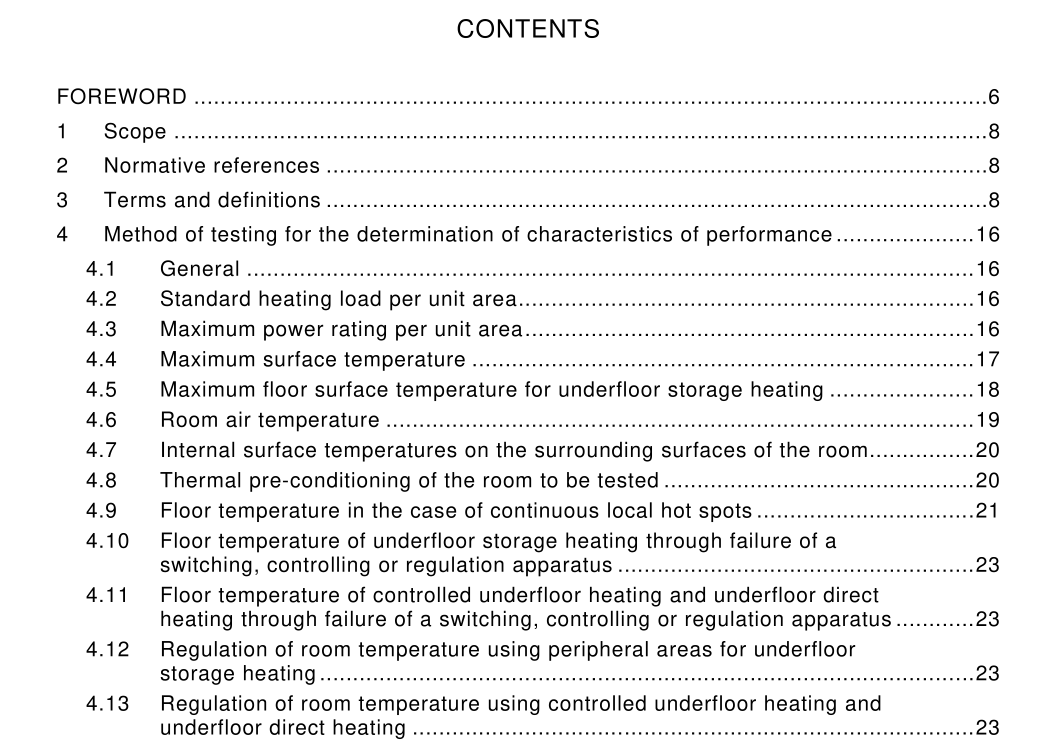IEC 62999 pdf download.Electric room heating – Underfloor heating – Performance characteristics – Definitions, method of testing, sizing and formula symbols
1 Scope
This International Standard applies to electrical underfloor heating of dwellings and all other buildings whose use corresponds to dwellings or is at least similar, having a maximum load bearing in use of 4 kN/m 2 . This Standard defines the main characteristics of electrical underfloor heating and establishes the method of testing of these characteristics as information for the user. This Standard does not deal with: – installation and safety requirements.
2 Normative references
IEC 60335-2-96, Household and similar electrical appliances – Safety – Part 2-96: Particular requirements for flexible sheet heating elements for room heating
3 Terms and definitions
For the purposes of this document, the following terms and definitions apply. 3.1 electrical underfloor heating system electrical underfloor heating, switching, control and regulation appliances and electrical installation 3.1 .1 underfloor heating in situ flooring constructed as an electrical underfloor heating system Note 1 to entry: It is generally laid on a dry, level, load-bearing substructure. 3.1 .2 underfloor direct heating underfloor direct heating, by which the heat generated from electrical energy is transferred with the least possible time lag to the room to be heated mainly via the surface of the floor Note 1 to entry: There is no restriction on the amount of time electrical energy can be converted into heat. 3.1 .3 underfloor warming underfloor warming increases comfort by means of pleasant warmth on the feet Note 1 to entry: It is not necessary to calculate the heat load of the room, and the insulating layers as the underfloor warming are not considered when calculating the heat load of the room.3.1 .4 controlled underfloor heating underfloor direct heating, by which the conversion of electricity into heat may be interrupted according to the provisions laid out in Note 1 Note 1 to entry: The conversion of electricity into heat may be interrupted – for no longer than 2 h continuously – no longer than 8 h total in a 24 h period. The period of use will be equivalent to at least the previous period of interruption. 3.1 .5 underfloor storage heating underfloor heating, by which the electrical energy is converted into heat and transferred with an intended time lag to the room to be heated mainly via the surface of the floor Note 1 to entry: The charging takes place during the charging time period t F and, as a rule, during an additional charging time t ZF of minimum 2 h. 3.1 .6 underfloor storage heating system underfloor heating, auxiliary heating, switching, control and regulation appliances and electrical installation 3.1 .7 electrical auxiliary heating necessary heating equipment with a rating Z Q in the room being heated, additional to, and different from, the underfloor heating (e.g. periphery heating, convector panels, etc.) 3.1 .8 heating circuit independently switched, regulated or controlled section of an underfloor heating system 3.2 duration of design charge duration of the charge for which the storage heating system is designed and which is determined as the basis for testing Note 1 to entry: It constitutes the largest continuous charging time within a period of 24 h. 3.3 auxiliary charge sum of the auxiliary charging times occurring between two design charge times 3.4 designed rating of a heating element manufacturer’s stated power rating for the heating element in W at the design voltage 3.5 capacity of a room capacity in W of underfloor heating in a room is the sum of the measured power ratings of the installed heating elements of an underfloor heating system in that room 3.7 maximum surface temtperature temperature which, for physiological purposes, cannot be exceeded on the uncovered upper surface of the flooring Note 1 to entry: This temperature may be exceeded in peripheral areas. 3.8 standard internal temperature value of the room temperature necessary for the calculation, i ϑ in °C; it is the resulting temperature, defined as the mean of the dry air temperature and the mean radiant temperature
IEC 62999 pdf download
